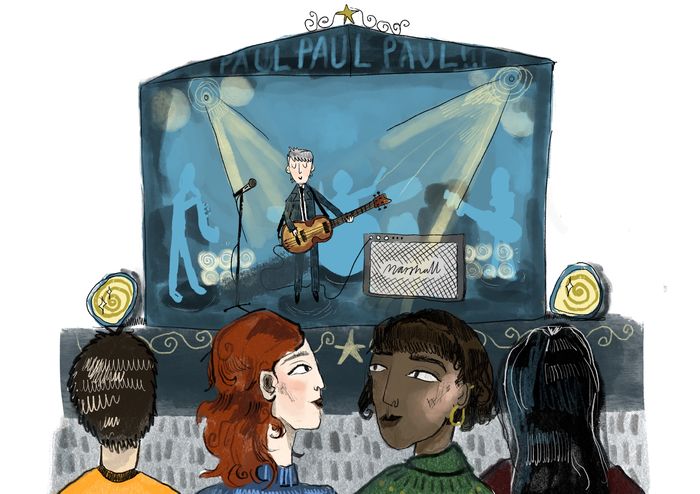The resurrection of the record: a love letter to physical music
Daisy Cooper looks at her record collection and wonders if it’s really worth the effort

When I realised that punk duo Lambrini Girls had pressed their new album Who Let the Dogs Out in the tasteful shade of ‘Gay Smurf Dick’ blue (accompanied by a free pack of matching rizlas) I knew that the records had to be making a comeback. 2023 marked the highest point of vinyl sales in the UK since 1990, and it has been on a gradual increase ever since. Against all the odds, and surprising many, records are making an unexpected rebirth in the digital age.
“It’s an obsession even the bounds of my bank account will never kill”
Maybe it’s the collectability that draws me to records, and the idea of having cabinets full of them in a sitting room one day. Some elitists scorn ‘fads’ of coloured vinyl and extras. But novelty is all with my record-collecting habit. With the release of their final record Hellfire, I was frankly overjoyed to receive a set of black midi-body builder fridge magnets, (which now adorn our fridge, much to my flatmate’s confusion) with the ex-band member’s heads photoshopped on. And I’ll admit I roped myself into buying FKA Twigs’ new album Eusexua in a clear variant for a staggering £38 in FOPP (unregretfully worth every penny) the other day. Nevertheless, I’ll inevitably be back in a few weeks’ time to buy special editions of Squid’s Cowards and Oklou’s Choke Enough upon their release – it’s an obsession even the bounds of my bank account will never kill.
Perhaps it’s the aesthetic – you might not even own a record player, but you want your walls covered in music. When you buy a record, you don’t only pay for and own a copy of the album’s music on the disc. It’s the album cover (an artwork in its own right) to have in a substantial size in your room to display at will and a sign that the music is something that is intrinsically yours.

Listening to a record is truly a worship of the small ceremony. To put a record on a turntable is a haptic experience, a methodical and mechanical exercise in slowing right down to appreciate music. In the context of being here at university, even walking to flip to the B-side could be a break from work between the sides of the album. If the songs flow into one another, begin abruptly or if there are spoken or orchestral interludes not on Spotify that accompany the record, you listen to the entirety of the album the way the artist intended it to be. Confronted as a collection of songs in succession, you may even discover new favourites amongst the ones you already know.
“Confronted as a collection of songs in succession, you may even discover new favourites amongst the ones you already know”
All that considered, this all sounds as if I am anti-streaming. Leaving the house to walk alone to the shops, to wait on a platform for an endlessly delayed train or working in the library without headphones is surely some form of self-torture. By all means, the digital complements the physical. Spotify pops up with records, CDs and merch when you click on an artist’s page. But digital music is disposable in the way that we cycle through playlists. We move on from moods, seasons change, and we all get bored. Records, as pretentious as it sounds, are artefacts, signifying times when albums have accompanied slices of life. Some of my records I hate by association now and will never return to them, but, nevertheless, they remain at the back of the collection forever.
Aside from the poeticism of eras gone by, collectors are posed with a more troubling conundrum of the incredible waste that physical music produces. Polyvinyl chloride (PVC) biscuits are melted down to press onto a stamper to create the grooves, releasing enormous amounts of Carbon Dioxide. More recently, to combat the waste that vinyl plastic creates- artists like Mary in The Junkyard did a recycled pressing of their EP This Old House made of off-cuts, setting a great (and cheap!) example for artists to come. Just as the great cynic Father John Misty meditates upon in ‘Now I’m Learning to Love the War’ – “when it’s my time to go / gonna leave things behind that don’t compose.” My dad jokes his record collection (featuring a wide run of Sarah Records twee singles and shoegaze classics) will one day become my inheritance.
Hauling my stacking system up three flights of stairs each term in first year was no mean feat, a strain I aim to continue, lugging my record player and vinyl across the years of my life. Materialistic tendencies will always get the better of me with music, but I don’t think I’ll ever go as far to be buried with my collection like Josh Tillman might suggest!
Want to share your thoughts on this article? Send us a letter to letters@varsity.co.uk or by using this form.
 News / Candidates clash over Chancellorship25 April 2025
News / Candidates clash over Chancellorship25 April 2025 Interviews / Dr Ally Louks on going viral for all the wrong reasons25 April 2025
Interviews / Dr Ally Louks on going viral for all the wrong reasons25 April 2025 Music / The pipes are calling: the life of a Cambridge Organ Scholar25 April 2025
Music / The pipes are calling: the life of a Cambridge Organ Scholar25 April 2025 News / Cambridge professor paid over $1 million for FBI intel since 199125 April 2025
News / Cambridge professor paid over $1 million for FBI intel since 199125 April 2025 Arts / Plays and playing truant: Stephen Fry’s Cambridge25 April 2025
Arts / Plays and playing truant: Stephen Fry’s Cambridge25 April 2025






